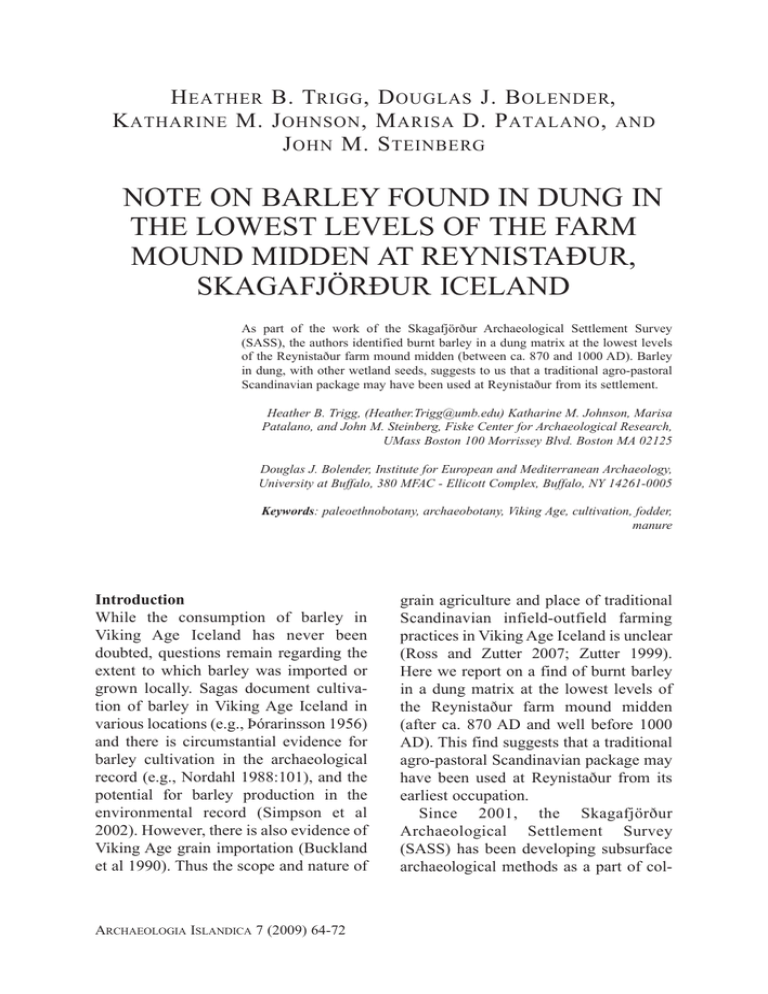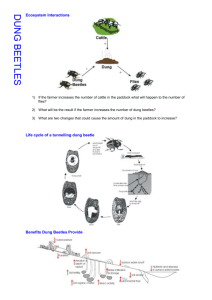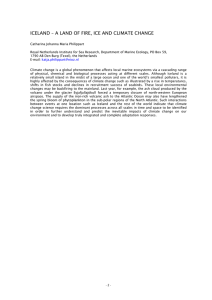NOTE ON bARLEy FOUND IN DUNG IN THE LOWEST LEVELS OF
advertisement

H eather B. Trigg , D ouglas J. B olender, K atharine M. J ohnson , M arisa D. P atalano , and J ohn M. S teinberg Note on barley found in dung in the lowest levels of the farm mound midden at Reynistaður, Skagafjörður Iceland As part of the work of the Skagafjörður Archaeological Settlement Survey (SASS), the authors identified burnt barley in a dung matrix at the lowest levels of the Reynistaður farm mound midden (between ca. 870 and 1000 AD). Barley in dung, with other wetland seeds, suggests to us that a traditional agro-pastoral Scandinavian package may have been used at Reynistaður from its settlement. Heather B. Trigg, (Heather.Trigg@umb.edu) Katharine M. Johnson, Marisa Patalano, and John M. Steinberg, Fiske Center for Archaeological Research, UMass Boston 100 Morrissey Blvd. Boston MA 02125 Douglas J. Bolender, Institute for European and Mediterranean Archaeology, University at Buffalo, 380 MFAC - Ellicott Complex, Buffalo, NY 14261-0005 Keywords: paleoethnobotany, archaeobotany, Viking Age, cultivation, fodder, manure Introduction While the consumption of barley in Viking Age Iceland has never been doubted, questions remain regarding the extent to which barley was imported or grown locally. Sagas document cultivation of barley in Viking Age Iceland in various locations (e.g., Þórarinsson 1956) and there is circumstantial evidence for barley cultivation in the archaeological record (e.g., Nordahl 1988:101), and the potential for barley production in the environmental record (Simpson et al 2002). However, there is also evidence of Viking Age grain importation (Buckland et al 1990). Thus the scope and nature of Archaeologia Islandica 7 (2009) 64-72 grain agriculture and place of traditional Scandinavian infield-outfield farming practices in Viking Age Iceland is unclear (Ross and Zutter 2007; Zutter 1999). Here we report on a find of burnt barley in a dung matrix at the lowest levels of the Reynistaður farm mound midden (after ca. 870 AD and well before 1000 AD). This find suggests that a traditional agro-pastoral Scandinavian package may have been used at Reynistaður from its earliest occupation. Since 2001, the Skagafjörður Archaeological Settlement Survey (SASS) has been developing subsurface archaeological methods as a part of col- Note on barley found at Reynistaður Setting and Methods Reynistaður, originally called Staður in Reynines, is the farmstead of the only Earl of Iceland, Gissur Þorvaldsson, who died in 1268 AD (McGrew 1970; McGrew and Thomas 1974). Before that, sometime in the 10th century, it was said to be the home of Þórður hesthöfði Snorrason and of his son, Þorfinnur karlsefnis, one of the early European settlers of Vínland (Kunz 2000). The farmstead is mentioned in several family sagas as well as in the Sturlunga sagas when it was a prominent estate of the Ásbirningar family. The farm continued to be an important economic and political center after the end of the Commonwealth as the site of a convent and as a parish seat. Reynistaður is situated where the Sæmundar River (Sæmundará) enters the fjord bottom and turns north to flow to the sea as the Reynistaður River (Staðará). The bend in the river has cut the south and east edges of the primary farm mound exposing up to 2.5 meters of domestic deposits (Figure 2). The midden begins just above the green Landnám tephra layer (LNL) dated from Greenland ice cores to AD 871±2 (Grönvold, et al. 1995) and AD 877±4 (Zielinski, et al. 1997). The farm mound was stabilized by 2003 with a bolder dyke placed along the bank of the river preventing further erosion of the deposit. In the summer of 2004 two profile sections were cleaned, drawn and photographed. The top of the main section of the southern profile is at E 573372.9, N 474202.8 and 8.5m above MSL (ISNET93). Both exposed profiles indicate intensive and continuous cultural activity following the LNL deposition (Figure 3 & 4). Both profiles have the same tephra layers and similar cultural deposits including the V-1000 AD, the 1104 AD (H1) and prehis- Hofsós Sauðárkrókur Blönduós REYNISTAÐUR Varmahlíð Figure 1. Map showing Skagafjörður with sites mentioned. lecting settlement pattern data for the area between Reynistaður and Víðimýri in Skagafjörður (Steinberg and Bolender 2004; Figure 1). Survey at Reynistaður conducted in 2001-2002 included shallow geophysical prospection and systematic coring of the homefield area followed by a series of assessment excavations. The survey has identified a number of outbuildings in the homefield and demonstrated a continuous occupation of the primary farm mound dating to the initial settlement of Iceland. Reynistaður appears to be the earliest farm in the immediate vicinity and is one of the earliest farms lying just north of the Langholt region. 65 Heather B. Trigg et al. R E Y N I S T A Ð A R 10 5 15 Á 10 15 Profiles 20 FA RM MOU ND 30 25 C H U RC H YA RD DRAIN AGE DITCH H OME FIE L D 5 0 10 20 30 40 meters toric H3/H4 tephras (Sigurgeirsson 2001). The east profile is the only one with the later (upper) grainy black tephra that is either the Hekla 1300 AD or the Hekla 1766 tephra. The cultural layers in both profiles are immediately on top of a mottled organic layer with small amounts of the dark green landnám tephra (see also Hallsdóttir 1987). The LNL was on top of a mixed aeolian deposit with substantial amounts of the H3/H4 tephra (Buckland, Dugmore and Edwards 1997), which overlay river sand and silt. The bottom cultural layers of both profiles are dominated by gray and black ash, while the middle layers are dominated by mixed turf. The upper layers are dominated by reddish peat ash. In 2007 the exposed midden deposits at Reynistaður from the southern profile were sampled for macrobotanical Figure 2. Map showing both Reynistaður profile locations. Figure 3. Photo of southern profile at Reynistaður. 66 Note on barley found at Reynistaður 2 1766 or 1300 4 2 1 2 4 5 4 5 6 7 8 9 10 11 12 13 14 Tephra Layers 1300 1104 1000 13 1: Humus 2: Organic layer (similar to 5) no clay lenses 3: Clay and turf 4: Red peatash 5: Compressed organic lenses (6 bands) -each about 3 cm think -separated by 3 cm think layer of clay Iron pan 6: Clay lenses(mottled) 7: Sand and ash with some charcoal (1000 within) 8-10: Banded layers with charcoal 11: LNL with organic lenses 12: H3/H4 tephra 13: River sand 14: Unknown white tephra Figure 4. Southern profile at Reynistaður. Results From Layer 11, we recovered charred and uncharred seeds, charred and uncharred dung, and charred and partially charred wood (Table 1). A 20-piece sample of the charred wood yielded birch (Betula), willow family (Salicaceae), conifer, and an unidentified diffuse porous wood, possibly rowan. Among the seeds, we found hulled six-row barley (Hordeum vulgare). These remains included charred and partially charred rachis fragments, the part of the plant that holds the kernel to the spike or ear. We also recovered seeds from herbaceous remains. A four-liter sediment sample from each of the layers was processed with a froth flotation device, and floating materials were captured in fine mesh cloth. Both the light and heavy fractions of the lowest cultural layer of the midden in the southern profile, Layer 11, was examined under 10 – 40x magnification with a Bausch and Lomb dissecting microscope, and identifications were verified by comparison with reference collections housed at the Fiske Center Paleoethnobotany Lab and with published sources (Hoadley 1990; Martin and Barkley 1961; Montgomery 1977). 67 Heather B. Trigg et al. plants such as chickweed (Stellaria), Polygonum, several types of wetland sedges (Cyperaceae), and a few grasses (Poaceae). While the proportions of charred to uncharred seeds change across taxa, for the most part, we found both charred and uncharred seeds of the same type. This fact, combined with the integrity of the stratigraphy and the presence of charred, partially charred, and uncharred wood and dung suggest to us that the uncharred plant materials were not later contaminants, but instead relate to the archaeological deposits. Taxon Hordeum kernels Hordeum glumes Hordeum rachis Caryophyllaceae* Polygonum Cyperaceae Poaceae Total Count 10 1 3 147 3 124 12 300 % 3% 0% 1% 49% 1% 41% 4% - *predominantly Stellaria Table 1. Seeds and Related Plant Parts Recovered from Layer 11. Interpretation The presence of charred dung and charred wood suggest that the people of Reynistaður were utilizing both types of fuel. Charred seeds are visible in the dung (Figure 6), so we believe that the dung is the source of at least some of the plant materials. In contrast to other Icelandic archaeological deposits (Nordahl 1988; Ross and Zutter 2007; Zutter 1999), the seed assemblage is not particularly diverse, being dominated by only two taxa. This lack of diversity may also indicate a single, limited, source for the seed assemblage: the dung. Both human and animal components to dung deposits have been identified at the Gjogur midden in Iceland (Ross and Zutter 2007), but with the exception of the barley, none of the plant remains appear to relate to plant foods typically consumed by people such as blueberries/ cranberries (Vaccinium) or crowberries (Empetrum). We believe that the majority of the seeds and some of the smaller plant materials come from livestock dung and thus relate to foddering or grazing practices. A substantial portion of the seeds were uncharred or only partially charred. This suggests that if dung was being burnt purposefully at Reynistaður, then it was being burned at very low temperatures (see Simpson et al 2003 for a discussion of burning temperatures). It is hard to imagine that at this early date at Reynistaður that any type of fuel was in short supply. Therefore, it is possible that the dung was not burned for heat but rather for its smoke to preserve food (e.g., Hangikjöt). The plant remains indicate that barley was consumed at Reynistaður. While the presence of rachis fragments may merely be a normal component of poorly cleaned grain stores, they may also signal that barley was grown nearby. Moreover, the presence of these plant parts among pieces of charred and uncharred dung indicate that the barley may have been eaten by the livestock, which perhaps were allowed to graze on harvested fields or were fed grains and harvesting waste. Ethnographic accounts and archaeological data indicate that grains and chaff that were deliberately fed to livestock as fodder are evident in the dung (Valamoti and Charles 2005; Derreumaux 2005). 68 Note on barley found at Reynistaður Figure 5. Photo of barley kernels from flotation sample of Layer 11. assemblage. In contrast wetland taxa, specifically Cyperaceae, dominated and comprised almost half of the assemblage. This suggests that the livestock were allowed to graze in these areas as well. The plant remains recovered from Layer 11 largely tell us about three activities: fuel use, field agricultural practices and livestock grazing. The presence of barley grains and chaff suggests that the people of Reynistaður cultivated this grain. It is clear that the early inhabitants were utilizing two fuel sources, wood and animal dung. While the seed assemblage associated with the dung is most similar to that of sheep found by Ross and Zutter (2007), we cannot determine if the dung comes from sheep, cattle or both. We can suggest that the peo- Agricultural fields may also have been the source of the weedy plant seeds that we recovered. Chickweed accounted for nearly half of the seed assemblage in Layer 11. They are a common contaminant of grain stores and are frequently found in animal dung. Chickweed is a low-growing weed, which invades cultivated fields and disturbed areas around habitations (Renfrew 1973:164). These seeds may have been ingested as the livestock grazed in barnyards or on harvested fields. Polygonum is a cosmopolitan genus, tolerating a variety of environmental conditions, and the seeds we recovered may have come from heathlands, disturbed areas, or wetlands. Seeds from grasses were present although grassland plants were not well represented in the Layer 11 botanical 69 Heather B. Trigg et al. ple of Reynistaður may have grazed their livestock on sedges and perhaps allowed them to forage on harvested fields. Conclusion We believe that level 11 at the Reynistaður farm mound midden is very early in the settlement sequence, soon after 871 AD and well before 1000 AD. Barley in charred animal dung at such a time suggests that the inhabitants were growing barley and, after it was harvested, letting the animals graze on the field. It is likely, based on the total seed assemblage that the animals were also grazing on wetlands at the same time, not surprising given Reynistaður’s location at the fjord bottom. If this is the correct interpretation, it implies that the complete Scandinavian agro-pastoral package was put into practice at Reynistaður soon after it was settled. Figure 6. Photo of dung recovered from flotation sample of Layer 11. expressed in this material are those of the authors and do not necessarily reflect the views of the any of the sponsors or supporters of this work. Reports and the raw data for this study can be obtained from http://www.fiskecenter.umb.edu/SASS. References Buckland, Paul C, Andrew J Dugmore and Kevin J Edwards (1997) Bronze Age myths? volcanic activity and human response in the Mediterranean and North Atlantic regions. Antiquity 71:581-. Buckland, Paul C, Andrew J Dugmore, D. W Perry, D Savory and Guðrún Sveinbjarnardóttir (1990) Holt in Eyjafjallasveit, Iceland: a paleoecological study of the impact of Landnám. Acta Archaeologica 61:252-271. Derreumaux, Marie (2005) How to detect foder and litter? A case study from the Roamn site “Le Marias de Dourges,” France. Vegetation History and Archaeobotany 14:373-385. Grönvold, Karl, N Óskarsson, S. J Johnsen, H. B Clausen, C. U Hammer, G Bond and E Bard (1995) Ash layers from Iceland in the Greenland Acknowledgments This material is based upon work supported by the US National Science Foundation under BCS grants 0107413, 0453892, and 0731371. Additional funding was provided by the Wenner-Gren Fund for Anthropological Research. Additional support came from the Commune of Skagafjörður and Icelandair. The work was done in conjunction with Byggðasafn Skagfirðinga, the Hólaskóli, and the Hólar Research Project. The SASS project operated under permits granted by Þjóðminjasafn Íslands & Fornleifavernd ríkisins. Tephrachrono­ logy was conducted by Magnús Á. Sigurgeirsson. We wish to thank the generous owners of Reynistaður: Sigurlaug Guðmundsdóttir and Helgi Jóhann Sigurðsson Any opinions, findings, and conclusions or recommendations 70 Note on barley found at Reynistaður archaeological point of view. Aun 12. Uppsala: Societas Archaeologica Upsaliensis. Renfrew, Jane (1973) Palaeoethnobotany. New York: Columbia University Press. Ross, Julie M and Cynthia Zutter (2007) Comparing Norse Animal Husbandry Practices: Paleoethnobotanical Analyses from Iceland and Greenland. Arctic Anthropology 44:62-86. Sigurgeirsson, M. Á. (2001) Archaeological research in Skagafjörður, North Iceland: Tephrachronological study - preliminary report. Simpson, Ian A, W. Paul Adderley, Margret Hallsdóttir, Magnús A Sigurgeirsson and Mjöll Snæsdóttir (2002) Soil limitations to agrarian land production in premodern Iceland. Human Ecology 30:423443. Simpson, Ian A, Orri Vésteinsson, W. Paul Adderley and Thomas H McGovern (2003) Fuel resource utilisation in landscapes of settlement. Journal of Archaeological Science 30:1401-1420. Steinberg, John M and Douglas J Bolender (2004) Rannsóknir á búsetuminjum í Skagafirði: Aðferðir og niðurstöður eftir tveggja ára starf. Árbók hins Íslenzka Fornleifafélags 20022003:107-130. Valmoti, Soultana Maria and Mike Charles (2005) Distinguishing food from fodder through the study of charred plant remains: an experimental approach to dung-derived chaff. Vegetation History and Archaeobotany 14:528-533. Zielinski, G. A, P.A Mayewski, L.D Meeker, Karl Grönvold, M.S GRIP ice core correlated with oceanic and land sediments. Earth and planetary Science Letters 135:149155. Hallsdóttir, Margret (1987) Pollen analytical studies of human influence on vegetation in relation to the Landnám tephra layer in Southwest Iceland. Lundqua Thesis, Volume 18. Lund: Lund University, Department of Quaternary Geology. Hoadley, R. Bruce (1990) Identifying Wood: Accurate Results with Simple Tools. New Town, CT: The Taunton Press. Kunz, Keneva (2000) Eirik the Red’s Saga. Translated by Keneva Kunz, in Jane Smiley & Robert Kellogg (ed.), The Sagas of Icelanders: a selection: 653-676. New York: Viking. Magnússon, Arni and Páll Vídalín (1927) Jardabók. Copenhagen: Hid Islenska Frædafélag í Kaupmannahöfn. Martin, Alexander C and William D Barkley (1961) Seed Identification Manual. Berkeley: University of California Press. McGrew, Julia H (1970) Sturlunga Saga, Volume 1. Saga of Hvamm-Sturla and the Saga of the Icelanders.. The library of Scandinavian Literature, Volume 9.. New York: Twayne. McGrew, Julia H and R. George Thomas (1974) Sturlunga Saga, Volume 2. The shorter sagas of the Icelanders.. The library of Scandinavian Literature, Volume 10.. New York: Twayne. Montgomery, F. H (1977) Seeds and Fruits of Plants of Eastern Canada and Northeastern United States. Toronto: University of Toronto Press. Nordahl, Else (1988) Reykjavík from the 71 Heather B. Trigg et al. Germani, S Whitlow, M.S Twickler and K Taylor (1997) Volcanic aerosol records and tephrochronology of the Summit, Greenland, ice cores. Journal of Geophysical Research 102:26625-26640. Zutter, Cynthia (1999) Congruence or concordance in archaeobotany: assessing micro- and Macrobiotanical data sets from Icelandic middens. Journal of Archaeological Science 26:833-844. Þórarinsson, Sigurður (1956) The thousand years’ struggle against Ice and Fire. Reykjavík: Bokautgafa Menningarsjod. 72 Notes for Contributors Scope Archaeologia Islandica is the first and only venue specially dedicated to aspects of Icelandic archaeology and material culture, and provides a forum for the wider dissemination of such work to the international community. The scope of the journal covers any aspect of archaeology and material culture relating to Iceland from the 9th century colonization of the island by Vikings to 19th century emigration of Icelanders to Canada - and beyond. Papers of archaeological fieldwork and artifact studies as well related historical, ethnographic and linguistic research are all welcomed, as are papers on material from outside Iceland but which are clearly relevant to discourses on Icelandic archaeology and material culture. should be designated for all correspondence. All texts must be sent in an electronic version and a hard copy in the post, and the two versions must be identical. Keep formatting to a minimum, and use consistent styles for sub-titling. Do not insert figures or tables in the text (see below). Illustrations and Tables All illustrations and tables must be sent as separate files and pages and should not be inserted into the text. For illustrations, files should preferably be a .tiff, . jpeg or .eps. Tables should be in Word or Excel. All figures and tables should be clearly numbered and be accompanied by a separate list of figure and table captions. Please mark clearly in the main text where the figures and tables are to be inserted. Submissions All submissions should be sent to the editor, Gavin Lucas, at Archaeologia Islandica, Bárugata 3, 101 Reykjavik, Iceland; emails should be sent to gavin@ instarch.is, marked Re: Archaeologia Islandica. References Referencing should be made in the text by quoting the author(s), year and page number in brackets at the relevant point - e.g. (Morris 1995, 123). Full details of the reference should be provided in a separate bibliography at the end of the paper, using set conventions as in the examples below. Note that surname or patronym will always come first, even for Icelandic names, and order will follow alphabetically: Manuscripts Contributions are accepted of variable length, but generally should aim to fall between 4000-8000 words. Manuscripts must be in English and be accompanied by an abstract not exceeding 150 words, with a list of 3-5 keywords. Authors should also provide their institutional affiliation (e.g. University) and an email address for correspondence; if there is more than one author, a principal author AÁBCDÐEÉFGHIÍJKLMNOÓPQR STUÚVWXYÝZÞÆÖ. 73 Review All submissions will be reviewed by one or more referees, and acceptance for publication will be dependent on their comments. The editor endeavors to respond to all submissions in as short a time as possible, but the review process may typically take 4-12 weeks. Examples of References: McGovern, T. H. (1994) "Management for Extinction in Norse Greenland", in: Crumley, C. L. (ed.) Historical Ecology. Cultural Knowledge and Changing Landscapes, pp.127-154, Santa Fe: School of American Research Press. Proofs Authors will receive one set of proofs for review; please note that only minor corrections can be made at this stage, and any major changes to the manuscript may result in deferral or cancellation of publication. Morris, C.D. and Rackham, D.J. eds. (1992) Norse and Later Settlement and Subsistence in the North Atlantic, Glasgow: University of Glasgow Snæsdóttir, Mjöll. (1989) "Stóraborg. En presentation", Hikuin XV, 53-58. Sveinbjarnadóttir, Guðrún. (1992) Farm Abandonment in Medieval and PostMedieval Iceland: an Interdisciplinary Study (Oxbow Monograph 17), Oxford: Oxbow. 74




